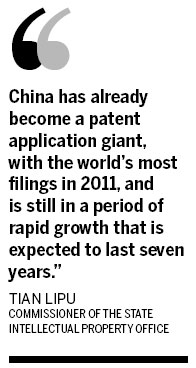Chinese officials need to make better use of the nation's current patent inventory, said the nation's top intellectual property official.
Right now, officials tend to narrowly focus on increasing the number of patents and patent applications when they should be looking for ways to monetize the nation's current intellectual assets, said Tian Lipu, commissioner of the State Intellectual Property Office.
In an interview with China News Service during the ongoing annual Chinese People's Political Consultative Conference, Tian said that the task at hand is to make China into a powerhouse for the commercialization of technologies, laying the foundation for a new stage of IP development.
"China has already become a patent application giant, with the world's most filings in 2011, and is still in a period of rapid growth that is expected to last seven years," he said.
Last year, China contributed 30 percent of the world's total 2.1 million patent applications, according to statistics from SIPO.
And, the ever-increasing number of patent filings is also highly consistent with growing investments in innovation across the country.
Though China certainly has a large number of patents, it does not necessarily follow that the patents are of high quality, Tian said.
The number of patent applications reflects a growing IP awareness among innovators and the population at large, he said, adding that it is "an encouraging phenomenon".

But, "in China, the number of patents awarded, which reflects the level of technology, is far less than the number of applications", he continued.
Furthermore, commercialized patents account for the smallest portion of total patent applications in the country. This category of patents is the most valued because they sharpen China's economic competitiveness and bring real benefits to people, he noted.
In some cities in developed eastern areas, authorities are employing new means to gain approval for more high-tech patents. However, for most provincial and municipal governments, emphasizing patent quantity while ignoring quality is a common problem, he said.
To solve the problem, the commissioner called on local governments and patent offices to adjust preferential policies for patent applications and to provide more support for enforcement and commercialization.
In addition, he also suggested placing a greater emphasis on invention patents rather than focusing on ones for utility models and design.
In 2011, the State Council included statistical indicators for patents in the Five-Year Plan for national economic and social development for the first time. According to the plan, the government hopes to achieve a patent ownership level of 3.3 patents per 10,000 Chinese residents by 2015.
"It is a low standard compared to the innovation-oriented countries across the world, which have an invention patent ownership rate of up to 30 per 10,000 people," Tian said.
It is a huge challenge for China to be on a par with them by 2020, and action must be taken as soon as possible to reach this goal, he added.
haonan@chinadaily.com.cn
(China Daily 03/13/2013 page17)

